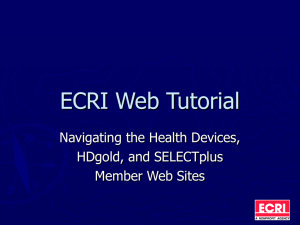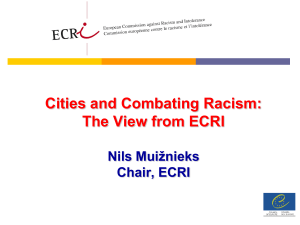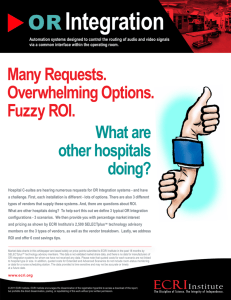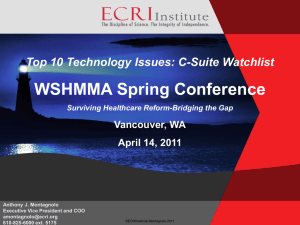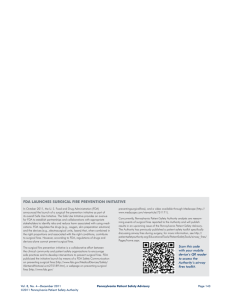Surg Fire Prevention, He Facility Managers Nov 2012, (C)
advertisement
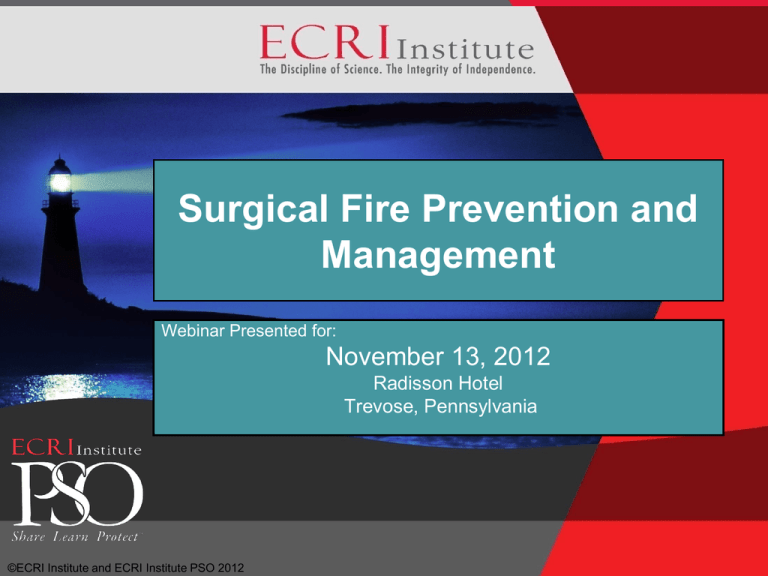
Surgical Fire Prevention and Management Webinar Presented for: November 13, 2012 Radisson Hotel Trevose, Pennsylvania 1 ©ECRI Institute and ECRI Institute PSO 2012 New Clinical Guidance on Surgical Fire Prevention and Management Mark Bruley, BS, CCE Vice President, Accident and Forensic Investigation ECRI Institute 5200 Butler Pike, Plymouth Meeting, PA Tel: 610-825-6000, Ext. 5223 Email: mbruley@ecri.org 2 ©2012 ECRI Institute New Clinical Guide to Surgical Fire Prevention1 New recommendations’ focus Developed by ECRI Institute in collaboration with the Anesthesia Patient Safety Foundation (APSF) 1. Eliminate open O2 delivery on the face 2. Secure patient airway if increased O2 needed 3. Use Pre-Op “Time-Out” to assess fire risks 1. Health Devices 2009 Oct;38(10): 314-332. See www.ecri.org/surgical_fires. 3 ©2011 ECRI Institute History – Surgical Fires 1800s-1980: Known and feared risk Flammable anesthetics ―Ether ―Ethyl Chloride ―Cyclopropane ―Fluroxene Technological ―Antistatic fixes precautions ―Conductive breathing circuit components ―Equipment chassis snorkels for fresh air 4 ©2011 ECRI Institute History – Surgical Fires 1980-2012: Insidious Hazard Oxygen enrichment under drapes Alcohol prepping agents Poor recognition of risk by clinicians No collaborating stakeholders NO technological remedies (e.g., no fire retardant drapes) 5 ©2011 ECRI Institute Low-Incidence Medical Errors (Technology and “Wrong Site”) Surgical Fire Prevention: Need for Action is Now Acknowledged 1. 2. 3. Top 3 Errors*: Retained Instruments “Wrong Site” Surgery Surgical Fires *Pennsylvania Patient Safety Authority. Three “never complications of surgery” are hardly that. Pa Patient Saf Advis 2007 Sep;4(3):82. [cited October 2, 2009]. Available from Internet: https://www.ecri.org/Documents/PA_PSRS/2007.09_Advisory.pdf 6 ©2011 ECRI Institute Others MRI Projectiles Medical Gas Mix-ups Transplant Tissue Matching Errors Luer Mis-Connections ECG/Apnea electrode electrocutions Endoscope Sterilization Failures CP Bypass Gas Embolism Bed Crushings Suffocation (bed rail or mattress) New Statistics: Surgical Fires 2007: Pennsylvania Patient Safety Reporting System (PA-PSRS)* 28 fires per year (based on 3 yrs of data) PA data scaled to USA 550 to 650 fires per year Mostly minor 2011 update review of PA-PSRS data underway – Initial impression is of similar numbers. *Pennsylvania Patient Safety Authority. Three “never complications of surgery” are hardly that. Pa Patient Saf Advis 2007 Sep;4(3):82. [cited October 2, 2009]. Available from Internet: https://www.ecri.org/Documents/PA_PSRS/2007.09_Advisory.pdf 7 ©2011 ECRI Institute Statistics: Anatomic Locations Anatomic Locations 44% Face, Head, Neck, Upper Chest 21% Airway 26% Elsewhere ON body 8% Elsewhere IN body >70% involve oxygen enrichment. 8 ©2011 ECRI Institute Surgical Procedures and Fires (11 Case Reports in Health Devices Jan 2003) Facial surgery ECMO cut down Carotid endarterectomy Temporal arterectomy Tracheostomy Oral surgery Tonsillectomy Infant surgery (PDAs) 9 ©2011 ECRI Institute Pneumonectomy Bronchoscopic surgery Cervical conization Hernia (infant) Circumcision (infant) C-section Pacemaker replaced Neurosurgery (laser) News Media: Putting a Face on Patient Safety Sept 25, 2008 August 18-25, 2003 10 L.A. Times October 7, 1988 News Media: Recent- November 2011 Medical References on Surgical Fires: Hundreds published over past 30 years. 12 Bibliography: www.ecri.org/surgical_fires 2003: Joint Commission Sentinel Event Alert Administration should alert of surgical staff on controlling ignition sources Manage fuels, especially flammable preps Establish guidelines for minimizing oxygen under drapes Establish testing procedure for staff Report fire incidents JCAHO. Preventing surgical fires [Sentinel Event Alert]. 2003 June 24; Issue 29. On Web: www.jcaho.org. 13 ©2011 ECRI Institute 2005-2009: Joint Commission Patient Safety Goals for Ambulatory and Office-based Surgery Educate staff on how to: Control heat sources Manage fuels Establish guidelines to minimize O2 under drapes Include independent licensed practitioners and anesthesia providers http://www.jointcommission.org/PatientSafety/NationalPatientSafetyGoals/06_npsg_amb.htm 14 ©2011 ECRI Institute New Initiatives 2006-2009 AORN Fire Safety Tool Kit (2006) Amer Soc Anesthesiologists (ASA): Practice Advisory for the Prevention and Management of Operating Room Fires (May 2008) Accepted by Amer Coll Surgeons and Amer Acad Otolaryngologists - Head & Neck Surgeons ASA and (APSF) Educational Initiative with ECRI Institute production of APSF peer-reviewed training video CME accredited online course coming 2012. 15 ©2011 ECRI Institute New Initiatives 2010 - 2011 APSF Educational video, produced by ECRI, released in April 2010 ECRI Institute completing APSF sponsored CME accredited online course: coming 2011. FDA’s Preventing Surgical Fires initiative website (new in Oct 2011) Aggregates links to APSF, ASA, AORN, ECRI Institute recommendations for surgical fire prevention. www.fda.gov/preventingsurgicalfires 16 ©2011 ECRI Institute Misconceptions Drapes are fire retardant treated. NO* Betadine™ skin prep is flammable. NO Get a fire extinguisher first to fight the fire. NO Lanugo hair is highly flammable in air. NO * There are no fire retardant drapes. The technology does not exist to make a textile that is fire retardant in elevated O2 levels. 17 ©2011 ECRI Institute How do we prevent surgical fires? Remedy lies within surgical team. Poster available free at: www.ecri.org/surgical_fires 18 ©2012 ECRI Institute APSF Surgical Fire Educational Video www.apsf.org 19 Surgical Fire – Putting Prevention Into Action Trans-disciplinary challenges Staff have different prevention responsibilities at different times during surgery Acute patient care needs vs. fire risks of open O2 delivery on face Continuing education is not a panacea Do we accept that surgical fires may be unavoidable? 20 ©2012 ECRI Institute Trans-disciplinary Hazard Surgical Fire Triangle Shows the staff most capable of controlling the associated aspect. 21 ©2012 ECRI Institute Oxidizers O2 & N2O enriched atmospheres exacerbate fire risk. Video – O2 Enriched Ignition and Flame Spread Royal Air Force Experiments c.1965 22 ©2012 ECRI Institute 23 ©2010 ECRI Institute How do we prevent surgical fires? Remedy lies within surgical team. Poster available free at: www.ecri.org/surgical_fires 24 ©2012 ECRI Institute Prevention NEW: Control Airway to Prevent Oxygen Enrichment Under Drapes Control Heat Sources Control Fuels Communicate Pre-Op Time Out Exception cases for open O2 25 ©2012 ECRI Institute Pre-Op “Time Out”* Identify and assess fire risks Use of open oxygen sources on the face? If YES for exceptional cases, then what? Alcohol-based skin prep? If YES, must be dry before draping! * Mathias JM. Scoring fire risk for surgical patients. OR Manager 2006 Jan;22(1):19-20. 26 ©2012 ECRI Institute NEW APSF Prevention Algorithm 2012 Anesthesia Patient Safety Foundation. Surgical fire injuries continue to occur: Prevention may require more cautious use of oxygen. APSF Newsletter Winter 2012; 26(3):42-43. (http://issuu.com/enews/docs/winter_2012/1) 28 ECRI Institute. New clinical guide to surgical fire prevention [guidance article]. Health Devices 2009 Oct;38(10): 314-332. ©2012 ECRI Institute NEW O2 RECOMMENDATIONS ECRI Institute and Anesthesia Patient Safety Foundation 2009 During Head, Face, Neck, and Upper-Chest Surgery: Use only air for open delivery to the face if the patient can maintain a safe blood O2 saturation without supplemental O2. If the patient cannot maintain a safe blood O2 saturation without extra O2, secure the airway with a laryngeal mask airway (LMA) or tracheal tube. 29 ©2012 ECRI Institute Supplemental Oxygen Exceptions Exceptions for Open O2 Delivery on Face: Where patient verbal responses may be required during surgery (e.g., carotid artery surgery, neurosurgery, pacemaker insertion) and where open O2 delivery is required to keep the patient safe. 30 ©2012 ECRI Institute 31 ©2012 ECRI Institute 32 ©2012 ECRI Institute Ignition Sources 33 ©2012 ECRI Institute Heat, sparks, and flares from electrosurgery are often ignition sources. 34 ©2012 ECRI Institute 35 ©2012 ECRI Institute Extinguishing Poster available free at: www.ecri.org/surgical_fires 36 ©2012 ECRI Institute 37 ©2012 ECRI Institute Extinguishing: Pat out if very small. 38 ©2012 ECRI Institute Extinguishing: Rip off! 39 ©2012 ECRI Institute 40 ©2012 ECRI Institute Extinguishing: Pull out! • Burned tracheal tube (top) from fatal fire during tracheostomy. • Tube was not removed immediately when fire started. 41 ©2012 ECRI Institute Extinguishers: Rarely Needed in OR For placement in each O.R. and use on patient: CO2 Extinguisher Not: Water, dry chemical, water mist, or fire blanket 42 ©2012 ECRI Institute New Clinical Guide to Surgical Fire Prevention1 New recommendations’ focus 1. Eliminate open O2 delivery during sedation for head, face, neck, and upper chest surgery 2. Secure patient airway if increased O2 needed 3. Use Pre-Op “Time-Out” to assess fire risks 43 ©2012 ECRI Institute Starting point for your policies and procedures. Full guidelines: see Health Devices 2009 Oct; 38(10). Poster available free at: www.ecri.org/surgical_fires 44 ©2012 ECRI Institute New Continuing Education Video and On-line Web Course A new video on surgical fire prevention has been produced by ECRI Institute for the Anesthesia Patient Safety Foundation (APSF). Released in April 2010. Free on the Web. On-line course with CME credits: Fall 2012 (from APSF through ECRI Institute) 45 ©2012 ECRI Institute Questions? Fire Prevention and Management in the Surgical Setting Webinar Presented for: Association of periOperative Registered Nurses October 22, 2012 46 ©2012 ECRI Institute For More Information Posters and Bibliography: www.ecri.org/surgical_fires Video, Algorithm, and CME course: www.apsf.org FDA Initiative: www.fda.gov/preventingsurgicalfires ECRI Institute. New clinical guide to surgical fire prevention [guidance article]. Health Devices 2009 Oct;38(10): 314-332. Contact: Mark Bruley Vice President, Accident and Forensic Investigation ECRI Institute Tel: (610) 825-6000 ext. 5223 Email: mbruley@ecri.org
